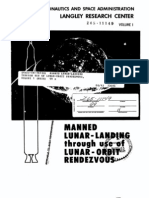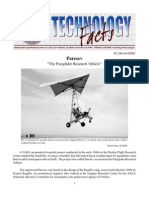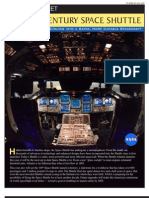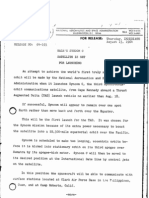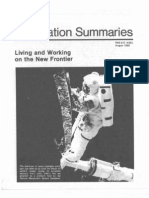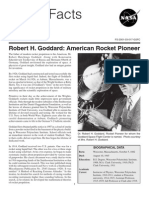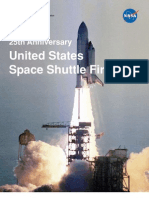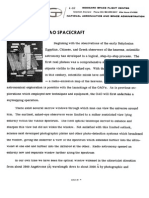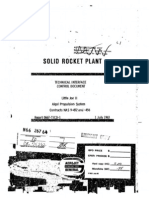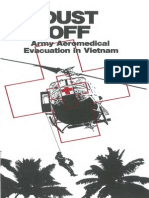NASA Facts Benefits From Apollo Giant Leaps in Technology
NASA Facts Benefits From Apollo Giant Leaps in Technology
Uploaded by
Bob AndrepontCopyright:
Available Formats
NASA Facts Benefits From Apollo Giant Leaps in Technology
NASA Facts Benefits From Apollo Giant Leaps in Technology
Uploaded by
Bob AndrepontCopyright
Available Formats
Share this document
Did you find this document useful?
Is this content inappropriate?
Copyright:
Available Formats
NASA Facts Benefits From Apollo Giant Leaps in Technology
NASA Facts Benefits From Apollo Giant Leaps in Technology
Uploaded by
Bob AndrepontCopyright:
Available Formats
NASA Facts
National Aeronautics and
Space Administration
Lyndon B. Johnson Space Center FS-2004-07-002-JSC
July 2004
Benefits from Apollo: Giant Leaps in Technology
The Moon, a luminous object in the
night sky that once inspired limitless
speculation, afforded the inspiration
for scientific discoveries in space and on
Earth – thanks to the Apollo Program.
The world was captivated on July 20, 1969,
when hundreds of millions watched through the lens of a
compact camera built specifically for space as man planted
his first step onto the lunar surface. Astronauts recorded
details of the momentous occasion with special pens that
allowed ink to flow freely in low gravity. Other technologies
like breathing apparatuses, fabric structures, communications
and protective coatings that made man’s step on the Moon To the Moon, through the roof
possible soon led to giant leaps in technology on Earth. Houston’s Reliant Stadium features the first retractable roof
NASA’s Office of Technology Transfer and Commercialization of its kind, made possible by NASA technology. NASA’s
licenses space-age technologies and connects with the private spacesuit fabric has fostered many new innovations, including
sector through business-to-business partnerships for the a permanent structure fabric developed for the Apollo Program
creation of products that improve lives here on Earth. Below and produced by New York-based Birdair, Inc. Pound for
are a few of the many viable commercial products America pound, the material is stronger than steel and weighs less than
enjoys today with roots that reach as far as the Moon. five ounces per square foot. Its translucency value, which
ranges from four to 18 percent, reduces lighting needs and
helps maintain the natural grass playing field. Its reflectivity
Playing with the Pros lowers cooling costs, and the Teflon coating reduces
maintenance costs by increasing the fabric’s resistance to
Sports and recreation manufacturers looked to NASA upon moisture, temperature extremes and deterioration. These
landing on the Moon in pursuit of improving their game. factors combine to lower initial costs and speed construction.
Walk, jog or run like an astronaut There are two applications for Birdair’s fabric; tension
“Moon Boot” material has revolu- structures that are supported by a network of cables and
tionized athletic footwear, improving pylons (used in the Reliant Stadium), or temporary air-
shock absorption and providing supported structures that consist of an outer membrane and
superior stability and motion an inner liner. On average, the use of fabric covering, which
control. Al Gross, a NASA Apollo can last up to 20 years, can help reduce building costs by as
Program engineer, used his space much as 30 percent. Spinoff 1978 and 1990
expertise to improve athletic shoes.
He substituted DuPont’s Hytrel Rearranging furniture in a stadium
plastic for foam materials in the Together, NASA and General Motors developed a way to
shoe’s mid-sole to eliminate cushioning loss caused by body move heavy loads more easily by lifting them onto a thin air
weight. An external pressurized shell and stress-free “blow cushion. Rolair Systems, Inc. was formed by former General
molding” process adapted from NASA spacesuit technology Motors’ engineers and has found commercial uses for the
was also used. The resulting compression chamber mid-sole innovation. Hawaii’s Aloha Stadium uses this technology to
allowed the popular shoemaker, AVIA Inc., to reconfigure re-arrange the stadium seating by moving an entire 7,000-seat
designs for specific sports and provide a “first step” toward a section on a cushion of air. A single operator can reposition
durable, foamless, non-fatiguing mid-sole. Spinoff 1991 this huge section in just half an hour. Spinoff 1978
Safeguarding You and Space Station. The solar array surface area currently on orbit
is 9,600 square feet, nearly half (40%) the size of a football
the Environment field (24,480 square feet). The skyscraper-sized solar arrays
Technologies guarding astronauts on the Moon now protect harness energy from the sun to power the Space Station.
you and the environment on Earth. Spinoff 1981
Astronaut flight suits Chlorine-free pools
fighting fires on Earth NASA’s silver ion technology has been used to create an
Fire hazards are much automatic pool purifier. Caribbean Clear Inc. system offers
greater in atmospheres an alternative to chemicals, such as chlorine and bromine.
containing a high percentage Purifiers use silver
of oxygen under pressure. ions, as used in
After the 1967 Apollo fire, Apollo Purification
NASA needed to find new Systems, to kill
ways to protect astronauts bacteria, copper ions
and their vessels. The and algae. They
Monsanto Company produce spa or pool
developed a chemically water that exceeds
treated fabric called EPA Standards
Durette that does not burn. for drinking water.
Spinoff 1994
A National Bureau of
Standards/NASA project Apollo innovation shakes up seismology
resulted in a lightweight
breathing system including Through a contract with NASA, Wyle-3S built an
facemask, frame, harness and air bottle marketed by Scott enormously forceful shock and vibration system to simulate
Aviation. Aluminum composite material was used to reduce liftoff stresses on the launch pad. In addition to earthquake
the weight of the overall apparatus, and the frame and testing, the company has adapted its shaking technology to
harness were designed to be much easier to put on and take evaluate railway cars, rail- or road-transported cargo, truck
off. Today nearly every major manufacturer of breathing refrigeration units and highway pavements without
apparatus incorporates NASA technology in some form, destroying or harming its surroundings. Spinoff 1979
helping to reduce the incidence of inhalation-related injuries.
Spinoff 1982
Medical Marvels from the Moon
Safety in security systems Apollo-based technologies launched major medical
Technology developed by NASA led to an intruder detector breakthroughs on Earth.
that helps prevent burglaries. Before prowlers can break in,
vibration-sensing detectors pick up movements of anyone Shocking heart
within range and relay warnings to portable radio receivers monitors
that alert guards or residents. Encased in a stainless steel NASA’s Apollo
tube, the detectors are implanted in the ground outside the technology was used
facility being protected - home, bank, industrial complex or by Medrad to develop
other facility. Spinoff 1978 the AID implantable
automatic pulse
Solar Panels: more generator, which
power, less pollution monitors the heart
Innovations developed continuously,
with technology from recognizes the onset
NASA’s Apollo lunar of a heart attack and
module program has delivers a corrective
created a renewable electrical shock. The
energy resource used on pulse generator is, in effect, a miniaturized version of
Earth and in space. Solar the defibrillator used by emergency squads and hospitals
panels collect electricity to restore rhythmic heartbeat after fibrillation. Once
by absorbing light when it implanted, it needs no specially trained personnel or
strikes the surface and additional equipment and consists of a microcomputer,
transfers it to a semiconductor. These solar panels are used a power source and two electrodes that sense heart
on calculators, street lights, houses and on the International activity. Spinoff 1980
Apollo sets the pace At Home with Apollo
St. Jude Medical’s Cardiac Many everyday home and consumer products today trace
Rhythm Management their roots to technologies born during Apollo missions.
Division used Apollo
technology to develop a No cords attached
programmable pacemaker
Utilizing NASA’s
system. A physician can
cordless innovations,
communicate with a
Black & Decker created
patient’s pacemaker by
cordless, lightweight
means of wireless telemetry signals transmitted through the
battery-powered precision
communicating head held over the patient’s chest. Where
instruments designed to
earlier pacemakers delivered a fixed type of stimulus once
give surgeons optimum
implanted, this system enables “fine tuning” of the device to
freedom and versatility in
best suit the patient’s changing needs. Spinoff 1980
the operating room. It
also led to today’s electric
Easier treatments for dialysis patients
screwdrivers, drills and other portable and chargeable
Technology originally developed under NASA contract by devices. Cordless power tools are also used to help build the
Marquardt Corporation, a chemical process was developed to International Space Station on orbit. Spinoff 1981
remove toxic waste from used dialysis fluid. This discovery
led to the development of a kidney dialysis machine using Clocks with rocks
“sorbent” dialysis, a method of removing urea from human
To keep missions on time, General
blood by treating a dialysate solution. The process saves
Time Corp. developed electrically
electricity and gives the patient greater freedom of
stimulated quartz crystals. Quartz
movement during treatment. Spinoff 1992
provides a stable time base,
giving clocks an accuracy of one
Cool ideas from Apollo
minute a year. By vibrating up to
NASA’s Cool Suit technology — originally designed to 4,194,304 times a second, these
keep astronauts cool during launch using a water circulation clocks keep millions of people on
system — is now used by hazardous materials workers, time around the globe. Spinoff 1976
armored vehicle crews, firefighters and NASCAR drivers.
Multiple sclerosis patients and children born without sweat Busting the dust
glands and a disorder that causes extreme sun sensitivity
Apollo astronauts needed a portable self-contained drill
wear built-in water circulation vests that provide them cool
capable of extracting core samples from 10 feet below the
comfort. A surgical personal cooling system has also been
lunar surface. Black & Decker used a specially developed
developed for medical personnel working in hot operating
computer program to optimize the drill’s motor and
room environments. And, horse saddle pads made with this
minimize power consumption. Refinement of the technology
technology can lower the horse’s temperature by 4 to 6
eventually led to the cordless vacuum cleaner called the
degrees. Another innovation includes a liquid-cooled bra that
Dustbuster. It has no hose, no cord, is 14 inches long, and
aids in the detection of cancer using infrared thermography.
also comes with a storage bracket that also serves as a
By increasing the temperature difference between normal
recharger. Spinoff 1981
and cancerous tissue through cooling, differentiation
becomes more apparent on thermograph. Spinoff 1979, 1982
and 1989
Precise prescription doses
Under one of the earliest contracts awarded during the
Apollo lunar landing program, Parker Hannifin Corporation
developed and produced equipment for controlling the flow
of propellants into the mammoth engines of the Saturn
Moonbooster. Today, Parker is supplying the huge valves
that control propellant flow from the Space Shuttle’s external
fuel tank to the engines of the Shuttle Orbiter as well as the
“peanut valve,” named for its small size. In 1977, NASA and
Parker created the Programmable Implantable Medication
System (PIMS) for continuous, computer-directed delivery
of precisely metered medication — insulin, for example —
within a patient’s body. Spinoff 1988
Crossing Boundaries Fueling alternative energy
Many technologies that began their journey to the Moon Liquid methane is becoming an energy alternative to
have crossed boundaries here on Earth, reaching vast expensive oil as a power source for automotive vehicles.
commercial markets for a kaleidoscope of uses. Methane, which is the principal component of natural gas,
costs less than half as much as gasoline, and its emissions
Digital are a lot cleaner than those from gasoline or diesel engines.
enhancements During the Apollo program, Beech Aircraft Corporation’s
Boulder Division developed expertise in producing fuel
Estee Lauder
storage tanks for liquid methane, a “cryogenic” fuel that
uses digital image
must be supercooled to remain liquid. The company has
analyzers and
since designed a system to convert cars and trucks to liquid
software based
methane operation. Liquid methane must be stored at a
on NASA lunar
temperature of 260 degrees below zero Fahrenheit. An
research to evaluate
optional twin-fuel system allows operators to use either
cosmetic products.
liquid methane or gasoline fuel. Spinoff 1982
Digital image
processing brings
out subtleties
otherwise
undetectable and
allows better
determination of
product’s effectiveness. This process allows Estee Lauder
to quantify changes in skin surface form and structure
caused by application of cosmetic preparations. NASA’s
digital imaging technology has also been used for CAT
scans, MRIs, radiography, microscopy in medicine as
well as various industrial and manufacturing uses.
Spinoff 1986, 1988 and 1990
Metallic mania
Insulation barrier made of aluminum foil laid over a core of
mylar protected astronauts and their spacecraft’s delicate
instruments from radiation as they ventured to the Moon So you need a sow
nearly four decades ago. Today, the metallic material has
In swine farming, 15 to 25 percent of piglets die before
found its way into numerous commercial products on Earth.
weaning, posing a serious economic problem for hog
Its reflective properties offer insulation and protection for
producers. Sometimes a sow will accidentally crush her
cars, trucks, homes and
piglets or she will reject or abuse a piglet. Frequently a
even food. Woven into a
litter is oversized and the sow cannot accommodate all
metallic blanket, a
her piglets for nursing or is just unable to lactate due to
shimmery shield now
physical disorders. Farmatic Inc’s Robotic Sow releases
protects all walks of life
a prescribed amount of formula from a refrigerated
from outdoor adventurers
compartment into a warming chamber, where milk is
exposed to extreme
heated to the desired temperature. At feeding time a heat
weather conditions to
lamp simulating a sow’s body warmth is automatically
emergency medical
turned on and the machine emits rhythmic grunts like a
patients who experience
mother pig summoning her piglets. As piglets scamper to
sudden body-temperature
their mechanical mother, a panel across the front opens to
drops. The same barriers
expose the row of nipples. The automated sow incorporates
that block heat and cold
NASA technology derived from miniature electronic heat
have also been used to
pumps and heating/cooling systems originally designed
muffle engine and exhaust
for Apollo spacecraft. The mechanical mother comes in
noise. Spinoff 1995
two models: 8 or 16 artificial nipples. Spinoff 1987
For additional information about NASA’s spinoffs, visit:
http://www.sti.nasa.gov/tto/spinoff.html
You might also like
- STS-47 Space Shuttle Mission ReportDocument39 pagesSTS-47 Space Shuttle Mission ReportBob AndrepontNo ratings yet
- Nasa Esas Appendix PDFDocument630 pagesNasa Esas Appendix PDFMaria EduardaNo ratings yet
- Manned Lunar Landing Through Use of Lunar Orbit RendezvousDocument99 pagesManned Lunar Landing Through Use of Lunar Orbit RendezvousBob AndrepontNo ratings yet
- A Charming Field For An EncounterDocument76 pagesA Charming Field For An EncounterBob Andrepont100% (2)
- Nineteenth Semiannual Report To Congress 1 January - 30 June 1968Document257 pagesNineteenth Semiannual Report To Congress 1 January - 30 June 1968Bob Andrepont100% (1)
- Development of Winged Reentry Vehicles 1952 - 1963 Becker1983Document79 pagesDevelopment of Winged Reentry Vehicles 1952 - 1963 Becker1983binglybert100% (1)
- Intelsat IV-A Press Kit 012676Document10 pagesIntelsat IV-A Press Kit 012676Bob AndrepontNo ratings yet
- The Evolution of A Space Feeding Concept For Project GeminiDocument16 pagesThe Evolution of A Space Feeding Concept For Project GeminiBob AndrepontNo ratings yet
- Paresev: "The Paraglider Research Vehicle"Document4 pagesParesev: "The Paraglider Research Vehicle"NASAdocumentsNo ratings yet
- NASA Facts PHYSX Pegasus Hyper Sonic ExperimentDocument3 pagesNASA Facts PHYSX Pegasus Hyper Sonic ExperimentBob AndrepontNo ratings yet
- Biosatellite DDocument35 pagesBiosatellite DBob AndrepontNo ratings yet
- NASA, The First 25 Years 1958 - 1983Document133 pagesNASA, The First 25 Years 1958 - 1983Bob AndrepontNo ratings yet
- Gemini Summary Conference SlidesDocument200 pagesGemini Summary Conference SlidesBob AndrepontNo ratings yet
- NASA Facts Space Shuttle Main Engine (SSME) Enhancements 2001Document2 pagesNASA Facts Space Shuttle Main Engine (SSME) Enhancements 2001Bob AndrepontNo ratings yet
- Into The Thermosphere The Atmosphere ExplorersDocument171 pagesInto The Thermosphere The Atmosphere ExplorersBob AndrepontNo ratings yet
- 21st Century Space ShuttleDocument8 pages21st Century Space ShuttleBob Andrepont100% (1)
- STS-4 Press KitDocument78 pagesSTS-4 Press KitBob Andrepont100% (1)
- Cox-Murray - Apollo The Race of The Moon Part 3Document151 pagesCox-Murray - Apollo The Race of The Moon Part 3Hipatia100% (1)
- From Runway To Orbit Reflections of A NASA EngineerDocument424 pagesFrom Runway To Orbit Reflections of A NASA EngineerBob AndrepontNo ratings yet
- Before This Decade Is Out Personal Reflections On The Apollo ProgramDocument428 pagesBefore This Decade Is Out Personal Reflections On The Apollo ProgramBob AndrepontNo ratings yet
- Explorer 1Document29 pagesExplorer 1Bob AndrepontNo ratings yet
- HELIOS-A Press KitDocument45 pagesHELIOS-A Press KitBob AndrepontNo ratings yet
- Syncom C Press KitDocument21 pagesSyncom C Press KitBob Andrepont100% (1)
- NASA Facts Space Shuttle External Tank ET-128 STS-124Document4 pagesNASA Facts Space Shuttle External Tank ET-128 STS-124Bob AndrepontNo ratings yet
- A Much Unsung Hero, The Lunar Landing Training Vehicle: And Other NASA RecollectionsFrom EverandA Much Unsung Hero, The Lunar Landing Training Vehicle: And Other NASA RecollectionsRating: 5 out of 5 stars5/5 (1)
- TheCape Military Space Ops 1971-1992Document186 pagesTheCape Military Space Ops 1971-1992PatchcollectorNo ratings yet
- NASA: 84985main DebusDocument25 pagesNASA: 84985main DebusNASAdocumentsNo ratings yet
- Proceedings of The Second Manned Spaceflight Meeting-Classified PortionDocument160 pagesProceedings of The Second Manned Spaceflight Meeting-Classified PortionBob Andrepont100% (3)
- Mars Pathfinder Landing Press KitDocument44 pagesMars Pathfinder Landing Press KitBob AndrepontNo ratings yet
- A Sustained Lunar Presence NSPC Report4220finalDocument13 pagesA Sustained Lunar Presence NSPC Report4220finalDavid YorkNo ratings yet
- NASA Mercury-Redstone 4 - Liberty Bell 7 Mission ReportDocument58 pagesNASA Mercury-Redstone 4 - Liberty Bell 7 Mission ReportOrion2015No ratings yet
- Magellan Mission To VenusDocument21 pagesMagellan Mission To VenusBob AndrepontNo ratings yet
- Living and Working On The New FrontierDocument8 pagesLiving and Working On The New FrontierBob Andrepont100% (1)
- NASA 120272main FS-015-DFRCDocument6 pagesNASA 120272main FS-015-DFRCNASAdocumentsNo ratings yet
- SA-5 Press KitDocument53 pagesSA-5 Press KitBob AndrepontNo ratings yet
- NASA Facts Robert H Goddard American Rocket PioneerDocument3 pagesNASA Facts Robert H Goddard American Rocket PioneerBob AndrepontNo ratings yet
- Vanguard A HistoryDocument329 pagesVanguard A HistoryBob AndrepontNo ratings yet
- NASA Facts The Shuttle EraDocument8 pagesNASA Facts The Shuttle EraBob Andrepont100% (1)
- Aeronautics in NACA and NASADocument80 pagesAeronautics in NACA and NASABob AndrepontNo ratings yet
- STS-71 Shuttle Mir Mission ReportDocument54 pagesSTS-71 Shuttle Mir Mission ReportBob AndrepontNo ratings yet
- NASA ISS Expedition 1 Press KitDocument48 pagesNASA ISS Expedition 1 Press KitOrion2015No ratings yet
- Science in Flux NASA's Nuclear Program at Plum Brook StationDocument197 pagesScience in Flux NASA's Nuclear Program at Plum Brook StationBob AndrepontNo ratings yet
- Ionosphere Explorer (Explorer XX) Press KitDocument22 pagesIonosphere Explorer (Explorer XX) Press KitBob AndrepontNo ratings yet
- 25th Anniversary United States Space Shuttle FirstsDocument15 pages25th Anniversary United States Space Shuttle FirstsBob AndrepontNo ratings yet
- Origins of NASA NamesDocument242 pagesOrigins of NASA NamesdroberNo ratings yet
- NASA Facts Biosatellite IIDocument12 pagesNASA Facts Biosatellite IIBob AndrepontNo ratings yet
- NASA Facts X-15 Hyper Sonic Research ProgramDocument6 pagesNASA Facts X-15 Hyper Sonic Research ProgramBob AndrepontNo ratings yet
- The RD 170 A Different ApproachDocument10 pagesThe RD 170 A Different ApproachvalstavNo ratings yet
- The Gemini Program Physical Sciences Experiments SummaryDocument554 pagesThe Gemini Program Physical Sciences Experiments SummaryBob AndrepontNo ratings yet
- NASA Facts Control Module Functional Cargo Block (FGB)Document2 pagesNASA Facts Control Module Functional Cargo Block (FGB)Bob AndrepontNo ratings yet
- Countdown NASA Lauch Vehicles and Facilities 1987Document29 pagesCountdown NASA Lauch Vehicles and Facilities 1987Bob Andrepont100% (1)
- Apollo-Soyuz Test ProjectDocument120 pagesApollo-Soyuz Test ProjectAviation/Space History LibraryNo ratings yet
- OAO SpacecraftDocument22 pagesOAO SpacecraftBob AndrepontNo ratings yet
- Little Joe II Algol Propulsion SystemDocument99 pagesLittle Joe II Algol Propulsion SystemBob Andrepont100% (1)
- Before This Decade Is Out: Personal Reflections on the Apollo ProgramFrom EverandBefore This Decade Is Out: Personal Reflections on the Apollo ProgramGlen E. SwansonRating: 4 out of 5 stars4/5 (4)
- Man on a Mission: The David Hilmers StoryFrom EverandMan on a Mission: The David Hilmers StoryRating: 4.5 out of 5 stars4.5/5 (2)
- Milestones of Flight: The Epic of Aviation with the National Air and Space MuseumFrom EverandMilestones of Flight: The Epic of Aviation with the National Air and Space MuseumRating: 4 out of 5 stars4/5 (1)
- The Design and Engineering of Curiosity: How the Mars Rover Performs Its JobFrom EverandThe Design and Engineering of Curiosity: How the Mars Rover Performs Its JobNo ratings yet
- American: Here Over The British Turn The The TheDocument100 pagesAmerican: Here Over The British Turn The The TheBob Andrepont100% (1)
- Chickamauga and Chattanooga BattlefiledsDocument68 pagesChickamauga and Chattanooga BattlefiledsBob Andrepont100% (4)
- Campaign For PetersburgDocument84 pagesCampaign For PetersburgBob Andrepont100% (3)
- Their Stories Women in The U.S.-mexican WarDocument2 pagesTheir Stories Women in The U.S.-mexican WarBob AndrepontNo ratings yet
- Castillo de San MarcosDocument70 pagesCastillo de San MarcosBob Andrepont100% (2)
- Chief Joseph's People and Their WarDocument28 pagesChief Joseph's People and Their WarBob Andrepont100% (1)
- The Occupation of MexicoDocument48 pagesThe Occupation of MexicoBob Andrepont100% (1)
- A Thunder of CannonDocument249 pagesA Thunder of CannonBob Andrepont80% (5)
- Boston and The American RevolutionDocument100 pagesBoston and The American RevolutionBob Andrepont100% (2)
- Lock Stock and BarrelDocument2 pagesLock Stock and BarrelBob Andrepont100% (3)
- CMH Pub 73-1 - Mexican War - Gateway South The Campaign For MonterreyDocument36 pagesCMH Pub 73-1 - Mexican War - Gateway South The Campaign For Monterreyorabera100% (1)
- Battlefields Around Fredericksburg PDFDocument48 pagesBattlefields Around Fredericksburg PDFBob Andrepont100% (2)
- Guns Along The Rio Grand Palo Alto and Resaca de La PalmaDocument32 pagesGuns Along The Rio Grand Palo Alto and Resaca de La PalmaBob AndrepontNo ratings yet
- From The Golden Gate To Mexico City The U.S. Army Topographical Engineers in The Mexican War, 1846-1848Document372 pagesFrom The Golden Gate To Mexico City The U.S. Army Topographical Engineers in The Mexican War, 1846-1848Bob AndrepontNo ratings yet
- Desperate Stand The Battle of Buena VistaDocument44 pagesDesperate Stand The Battle of Buena VistaBob Andrepont100% (1)
- The Maryland and Fredericksburg Campaigns, 1862-1863Document64 pagesThe Maryland and Fredericksburg Campaigns, 1862-1863Bob Andrepont100% (2)
- The Civil War Ends, 1865Document76 pagesThe Civil War Ends, 1865Bob Andrepont100% (2)
- CMH Pub 75-18 The Army and Reconstruction, 1865-1877Document76 pagesCMH Pub 75-18 The Army and Reconstruction, 1865-1877Bob Andrepont100% (2)
- Advanced Redoubt of Fort BarrancasDocument2 pagesAdvanced Redoubt of Fort BarrancasBob AndrepontNo ratings yet
- A House DividedDocument1 pageA House DividedBob AndrepontNo ratings yet
- The Civil War in The Trans-Mississippi Theater, 1861-1865Document60 pagesThe Civil War in The Trans-Mississippi Theater, 1861-1865Bob Andrepont100% (4)
- The Civil War On The Atlantic Coast, 1861-1865Document64 pagesThe Civil War On The Atlantic Coast, 1861-1865Bob Andrepont100% (3)
- Dust Off Army Aeromedical Evacuation in VietnamDocument148 pagesDust Off Army Aeromedical Evacuation in VietnamBob Andrepont100% (2)
- The Chesapeake Campaign, 1813-1814Document60 pagesThe Chesapeake Campaign, 1813-1814Bob Andrepont100% (2)
- Atlanta and Savannah Campaigns - 1864Document84 pagesAtlanta and Savannah Campaigns - 1864Bob Andrepont100% (4)
- The Gulf Theater, 1813-1815Document52 pagesThe Gulf Theater, 1813-1815Bob Andrepont100% (1)
- The Petersburg and Appomattox Campaigns, 1864-1865Document72 pagesThe Petersburg and Appomattox Campaigns, 1864-1865Bob Andrepont100% (4)
- Campaigns in Mississippi and Tennessee February-December 1864Document68 pagesCampaigns in Mississippi and Tennessee February-December 1864Bob Andrepont100% (3)
- The Creek War of 1813-1814Document44 pagesThe Creek War of 1813-1814Bob AndrepontNo ratings yet
- Article Read: Talk View Source View HistoryDocument6 pagesArticle Read: Talk View Source View Historyysabelle rocoNo ratings yet
- Lesson 2 ElsDocument44 pagesLesson 2 ElsJhellee AquinoNo ratings yet
- Effects of Changing Climate On Weather and Human Activities PDFDocument50 pagesEffects of Changing Climate On Weather and Human Activities PDFpawlittooNo ratings yet
- Gess 203Document8 pagesGess 203Kalpavriksha1974No ratings yet
- 4ESS T2 - Plate Tectonics LabelingDocument5 pages4ESS T2 - Plate Tectonics LabelingSpongeBob SquarePantsNo ratings yet
- Grade 7 Budget of Work q4Document6 pagesGrade 7 Budget of Work q4Charity LopezNo ratings yet
- CT Techm 2017 01SDocument14 pagesCT Techm 2017 01SSumanth_YedotiNo ratings yet
- Geography SSC Nda CdsDocument24 pagesGeography SSC Nda CdsphysicspalanichamyNo ratings yet
- F2 Geog TQDocument27 pagesF2 Geog TQkmuliliNo ratings yet
- Herbert Spencer Origin and Function of MusicDocument68 pagesHerbert Spencer Origin and Function of Musicjrhee88100% (2)
- Beachy Head The Negation of The SolarDocument4 pagesBeachy Head The Negation of The SolarMiguelNo ratings yet
- LIBRO R Buckminster Fuller Critical Path PDFDocument510 pagesLIBRO R Buckminster Fuller Critical Path PDFjoel100% (2)
- DR Georgi Stankov June 10 2013Document5 pagesDR Georgi Stankov June 10 2013Beáta Kovács-KalitaNo ratings yet
- Read The Following Passage and Mark The Letter A, B, C or D On Your Answer Sheet To Indicate The Correct Answer To Each of The Questions From 1 To 10Document15 pagesRead The Following Passage and Mark The Letter A, B, C or D On Your Answer Sheet To Indicate The Correct Answer To Each of The Questions From 1 To 10Nguyễn Hoàng Như ÝNo ratings yet
- What Role Does Natural Environment Play in Our LifeDocument12 pagesWhat Role Does Natural Environment Play in Our LifeНастя НелипонькаNo ratings yet
- Save EarthDocument2 pagesSave EarthAncient Sadist100% (1)
- Lec2 - Weather and HydrologyDocument120 pagesLec2 - Weather and HydrologyKate RizelleNo ratings yet
- Application of Remote Sensing IN Civil Engineering: Rahees.P CS6 NO:40Document33 pagesApplication of Remote Sensing IN Civil Engineering: Rahees.P CS6 NO:40adilppNo ratings yet
- 5 Themes MrhelpDocument16 pages5 Themes Mrhelpapi-236043597No ratings yet
- 2050 ScenariosDocument68 pages2050 ScenariosDiego FernandezNo ratings yet
- Engineering Geology 1st UnitDocument9 pagesEngineering Geology 1st UnitSaikrupaVempatiNo ratings yet
- Waves, Tides (Classwork, Homework)Document9 pagesWaves, Tides (Classwork, Homework)api-262318021No ratings yet
- It's Up To You, Now!Document130 pagesIt's Up To You, Now!lenhoubenNo ratings yet
- Teaching Ideas: Unit 8 The Earth Possible LessonsDocument8 pagesTeaching Ideas: Unit 8 The Earth Possible LessonschristalNo ratings yet
- Element of ClimateDocument5 pagesElement of ClimatePEkar Kus-kusNo ratings yet
- Dinosaur Extinction TheoriesDocument4 pagesDinosaur Extinction TheoriesRahma sayedNo ratings yet
- Biology Project: Oxygen CycleDocument2 pagesBiology Project: Oxygen CycleByXhixxRDNo ratings yet
- Solar System FactsDocument40 pagesSolar System FactsAldrin PaguiriganNo ratings yet
- Examenul de Bacalaureat 2005 Proba Scrisa La Limba EnglezaDocument2 pagesExamenul de Bacalaureat 2005 Proba Scrisa La Limba EnglezaMon CeleronNo ratings yet
- Midterm ExamDocument25 pagesMidterm Examjo_aligoraNo ratings yet


